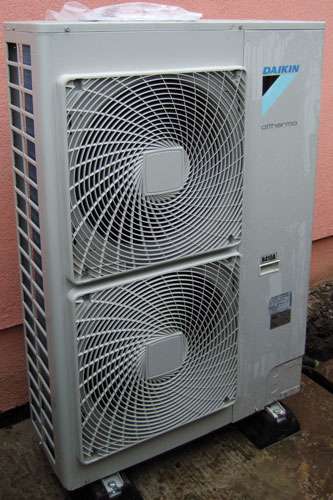
Following my article last month, I’m sharing a fascinating interview I had with Tom Lankester. I had wanted to interview Tom for a while because he’d had a heat pump since 2013 and therefore knew the “ins and outs” of it. Recently I’d heard about people who installed heat pumps and then removed them because they didn’t provide enough warmth. I was therefore delighted when Tom told me he’d had his for nine years and it was working well for his family.
Tom and his wife moved into their current house in 1997. It was a standard 1980s house which Tom was keen to improve on in terms of its energy efficiency. He looked into getting a heat pump, but soon realised there were a number of things he needed to fix first. In 2003 he installed solar panels for hot water but soon noticed his gas bills remained the same, so the panels weren’t making a big difference to his energy consumption. Tom discovered that only about 10% of standard energy consumption in a house is given to heating hot water, 1% to cooking, the rest to heating the house.
The second revelation he made was that we’re not actually heating our houses when we turn on the heating, we’re heating the outside, yes, you got that right, the heat is just moving through the house on its way out! Tom said it’s as if we switch on a two bar electric fire and leave it outside our front door all day! Not very funny in the present situation of course BUT, if we insulate our homes properly, it’s a slower journey to the outside and we really need concentrate on that.
To address the heat loss from his walls and windows, Tom installed triple glazed windows at the back of the house (which faces North) where there are patio doors (these had made the room so cold in the winter that it had to be shut off and the curtains kept closed). Fortunately, his house had cavity walls which he insulated too. The other big game-changer was externally insulating ¾ of the house with fibreboard and additional solar panels in 2009.
What effect did all this have when it was put to the test? You may remember an extremely cold spell in 2009 with plenty of snow that hung around for ages. Nonetheless, after those cold weeks, Tom’s gas bills had dropped by 30% and he no longer had to close off the back room with the patio doors!
It was at this point Tom proceeded to have a heat pump, which in itself proved to be a learning curve, as getting the right size one is critical. All the improvements mentioned above minimised the need for a big, expensive heat pump.
Tom obtained three heat pump quotes:
i) the first company wanted to rip up the floor and put in underfloor heating, and their specification for the heat pump was huge. Underfloor heating (which is the gold standard for a heat pump) means that a heat pump works more efficiently and effectively. Ideally you want as small a difference between the outside and inside as possible.
ii) the second company suggested a smaller heat pump but wanted to replace the radiators with larger ones (which is quite common). The reason for this is that bigger radiators provide more surface area to give more heat.
iii) Tom selected the third company – their installation engineer came with the heat pump company’s (Dakin) engineer. They’ve been making heat pumps for over 50 years. They looked at Tom’s bills to consider his usage and then recommended a Dakin high temperature heat pump through his existing radiators. Furthermore, they installed the external unit (which is effectively a large fan) and replaced the boiler with a hydrobox the same size, (a hydrobox takes the fluid from outside and heat transfers it into the hot water system and hot water tank). The plumbing was the same size as for a standard boiler. The only other work involved putting in a trench around the outside of the house to connect to the external unit. All in all, there was minimal disruption which of course reduced the overall cost.
Tom doesn’t run his heat pump constantly. He utilises an economy 7 tariff in the early hours of the morning to heat the house, and the external wall insulation acts like a blanket around the house. Finally, in 2013, Tom’s house went carbon negative because he’d sequestered two tons of wood onto the outside of the house as carbon storage.
There are some notable differences with a heat pump compared to a gas boiler: a heat pump doesn’t heat up as quickly and tends to work better if it just chunters away in the background. This isn’t necessary of course if the house has been properly insulated both inside and more importantly, outside! Happily, a heat pump will use the heat it generates three times as efficiently as a gas boiler and as already mentioned, if used first thing in the morning, it’s cheaper to run and less carbon intense.
Tom’s gas bill disappeared to almost nothing at this point while the electricity shot up (because heat pumps run on electricity) but was still lower overall than before the heat pump was fitted. Regarding the payback time on the outlay for a heat pump, Tom said that he’s far less dependent on the gas market generally (which is good for the planet, and good considering the effects now being felt as a result of dependence on countries like Russia).
The bottom line is the heat pump is like a home insurance policy for Tom’s energy for the next twenty years or so. It’s certainly given me a lot to think about and a much clearer idea of how to go about it.
Sharon Duggan
Cranleigh Climate Action Group
www.facebook.com/howtoliveagreenerlife






